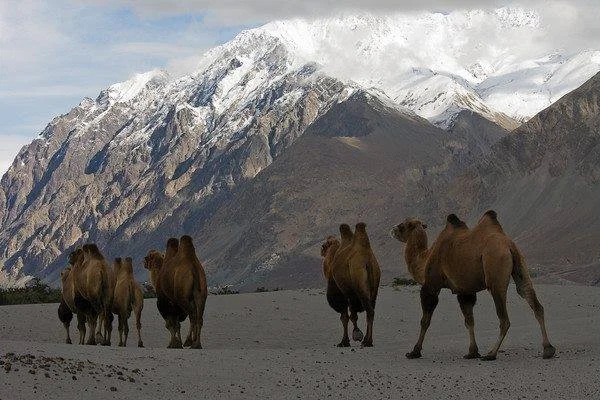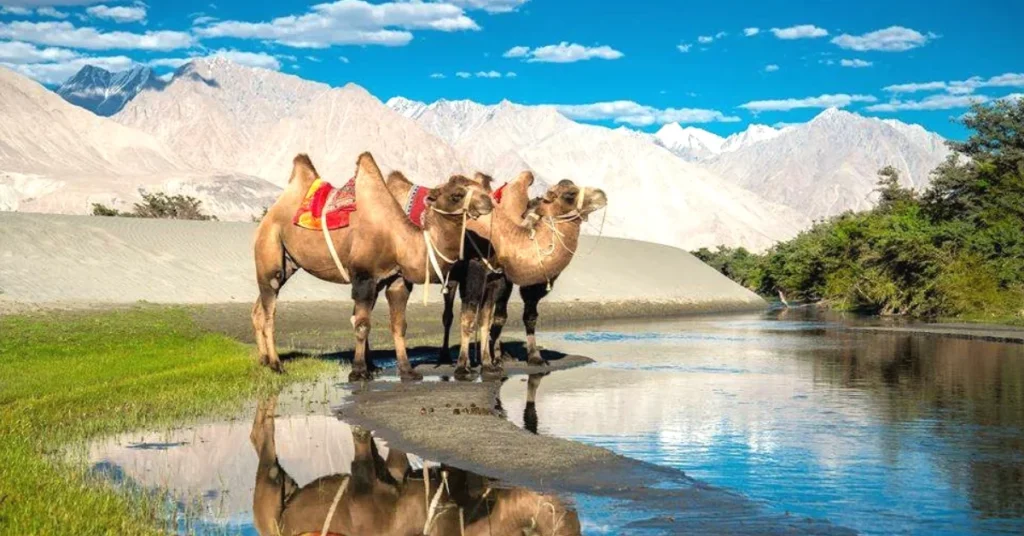From the brink of vanishing to staging a remarkable comeback, these adorable creatures are worthy of a jubilant celebration! 🎉
Once the beating heart of the Silk Road, Ladakh now stands as a solitary frontier of India, echoing tales of bygone eras. Centuries ago, intrepid traders from Central Asia, West Asia, and Europe embarked on the arduous journey through Ladakh, laden with a caravan of treasures—salt, grain, pashmina wool, cannabis resin, silk yarn, cotton, and indigo—woven into the fabric of the rugged terrain.
Picture this: Central Asian traders forging ahead, accompanied by the regal Bactrian camel, a majestic caravan master. These double-humped wonders, capable of shouldering hefty loads and toiling tirelessly for six to eight hours a day, were the unsung heroes of the grand trade odyssey.
In the 1870s, as recounted by local historian Haji Abdul Razzaq Jamsheed in his chronicle ‘The Tale of Nubra Valley,’ the Bactrian camel made its dramatic entrance into Ladakh. Originating from the mystical lands of Yarkand in the Xinjiang province of contemporary China, these camels became living symbols of the vibrant trade routes. Yet, when the curtain fell on this route in 1950, some camels found a new home with local traders, while the wounded warriors were bartered.
Enter the geopolitical tides, and the Bactrian Camel found itself marooned in Ladakh’s Nubra Valley, abandoned as modern vehicles eclipsed their once-vital role. Neglected and on the brink of oblivion, these camels fought a silent battle for survival, facing extinction as the 21st century dawned.
But lo and behold! The early 2000s heralded a renaissance for these resilient creatures, thanks to the unsung heroes of Nubra Valley—the local residents and savvy merchants.
So, what sets the Bactrian Camel apart? Unlike its single-humped cousin in the Thar desert, Rajasthan, this camel flaunts not one but two distinctive humps. Enduring temperatures plummeting to minus-40 degrees Celsius, boasting high disease resistance, and flaunting remarkable feed conversion efficiency, these camels became a subject of fascination for researchers.
In the words of Sudhirendar Sharma, founder of the Eco-logical Foundation, New Delhi, “This camel can propagate naturally, roaming and grazing in the range-land all year round, without any supplementary feed.” A nomad of the wild, these camels, akin to their Arabian kin, perspire sparingly, conserving fluids over extended periods. National Geographic adds a jaw-dropping fact: a parched Bactrian camel can guzzle down a staggering 30 gallons of water in just 13 minutes.
From a mere dozen survivors in the early 1980s, when whispers of extinction grew louder, their numbers have surged to nearly 220 today, including 21 spirited calves below the age of one. Some locals even weave tales of a burgeoning population, hinting at a count of 250, awaiting official endorsement.
The metamorphosis began with the rhythmic footsteps of camel safaris echoing through Hunder village in 2003. As this initiative gained momentum among both locals and globetrotters, a wave of fervor to safeguard these majestic beings swept over the valley. Cooperative societies, such as the Central Asia Camel Safari in Hunder, emerged, and neighboring villages formed their own cavalry of support groups. Steering this caravan of change was none other than the village administrative body (VAB), helmed by a ‘Goba’ or village headman, orchestrating the successful preservation of these once-forgotten camels.

“In the saga of Bactrian camels, the Village Administrative Body (VAB) emerges as the unsung guardians of Ladakh’s communal grazing lands—an ancient feast for our hump-backed comrades. Think of them not just as visitors; these camels are the bon vivants owned and managed by the very households that have mastered the art of camelian coexistence,” as uncovered in the mystical scrolls of yet another research paper in the enigmatic Current Science.
The state departments, akin to background actors, step into the spotlight with the occasional cameo—prescribing medicinal remedies for our camel compatriots and sketching grandiose blueprints for their conservation odyssey.
For those yearning to dance with the shadows of the Siachen Glacier or trace the poetic meanders of the Shyok River, the local sorcerers of Ladakh’s communities, joined by the wizards of tourism, have crafted a safari spell that reads like a page-turner. Imagine yourself traversing the rugged landscapes, riding the camel waves like a ship navigating the desert sea.
Yet, in this symphony of hooves, a dissonant chord echoes. Enter the stage left, the vigilant guardians of animal ethics, armed with concerns about the perceived mistreatment of our noble camel companions. Ropes that pierce noses become the silent narrators of a tale written in blood, or so the activists claim. And then, the whispers of lashings, a dark undercurrent to the camel ballet during the tourist crescendo from July to September.
But wait! The local custodians, the choreographers of these safaris, raise their voices in a spirited counterpoint. While admitting to a hint of nose-bleeding—a mere quirk, they argue, of the camel waltz—accusations of lashings are met with a resounding chorus of denial. These camels, they declare with unwavering pride, are not just assets but esteemed members of the extended family. Why, they ask, would they mar the harmony of their existence with ill-treatment?
And now, enter the economic overture. An average camel maestro, conducting a symphony of five, earns a cool Rs 4 lakh per season, say reports. The dream weavers of tourism envision an encore, urging an extension of the tourist season, painting a portrait where families could dance to a richer tune. In Hunder’s enchanted realm alone, 45 families compose their livelihoods through these magical rides, entwining their fate with the very threads of the camel tapestry. 🐫✨

In the labyrinth of perspectives, where safari operators and animal rights activists find common ground, it’s the stark absence of healthcare amenities for our camel companions that steals the spotlight—an obligation, one would argue, that falls under the purview of the animal husbandry department. A shared concern reverberates over the vast expanse, echoing worries about these camel wanderers meandering into private domains, causing crop chaos and property pandemonium.
The tales of locals resorting to desperate measures to shoo these hump-backed intruders away have found their way into the narrative. Yet, the climax to this conflict remains an unwritten chapter, awaiting the script of how the authorities will navigate this complex conundrum.
Amidst these skirmishes and concerns, the resounding heartbeat is the sight of these creatures, unintentionally left behind in Ladakh’s tapestry, making a resurgence—an unintentional encore that paints the canvas of the landscape with hope. 🐫
